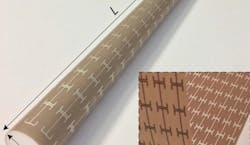Conformal metasurface coating eliminates crosstalk and shrinks waveguides
A team of electrical engineers at Penn State (State College, PA) has a way to simultaneously control diverse optical properties of dielectric waveguides by using a two-layer metamaterial coating, each layer with a near-zero thickness and weight.1
According to Zhi Hao Jiang, former postdoctoral fellow at Penn State and now a professor at Southeast University, Nanjing, China, metasurface coatings allow researchers to shrink the diameter of waveguides to highly subwavelength domensions and control the waveguiding characteristics with unprecedented flexibility.
The researchers developed a material that is so thin it is almost two-dimensional, with characteristics that manipulate and enhance properties of the waveguide.
"In terms of applications, these would include millimeter-wave/terahertz/infrared systems for sensing, communications, and imaging that need to manipulate polarization, squeeze signals through waveguides with a smaller cross-section, and/or require dense deployment of interconnected components," says Jiang.
The researchers developed and tested two conformal coatings, one for guiding the signal and one to cloak the waveguide. (The prototype's radiation-carrying frequency was 3.66 GHz, although the design is valid for higher frequencies as well.) They created the coatings by engineering the patterning on the surfaces to enable new and transformative waveguide functionality, including twisting of the metasurface unit cells. The coatings were applied to a rod-shaped, Teflon waveguide with the guiding layer touching the Teflon and the cloaking layer on the outside.
The researchers note in their Nature Communications paper that "the effectiveness of the artificial coating can be well maintained for waveguide bends by properly matching the dispersion properties of the metasurface unit cells." Although the coating can be applied to a bend in the waveguide, the waveguide cannot be bent after the coating is applied.
Source: http://news.psu.edu/story/479317/2017/08/25/research/conformal-metasurface-coating-eliminates-crosstalk-and-shrinks
REFERENCE:
1. Zhi Hao Jiang et al., Nature Communications (2017); doi: 10.1038/s41467-017-00391-0
About the Author
John Wallace
Senior Technical Editor (1998-2022)
John Wallace was with Laser Focus World for nearly 25 years, retiring in late June 2022. He obtained a bachelor's degree in mechanical engineering and physics at Rutgers University and a master's in optical engineering at the University of Rochester. Before becoming an editor, John worked as an engineer at RCA, Exxon, Eastman Kodak, and GCA Corporation.

